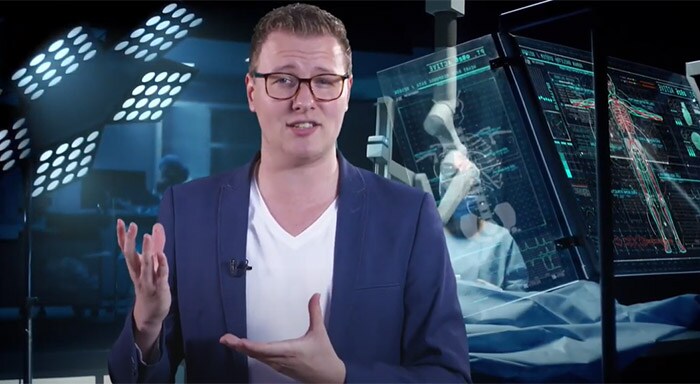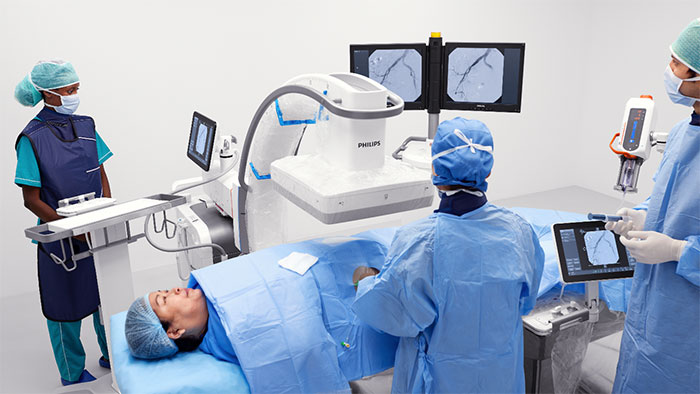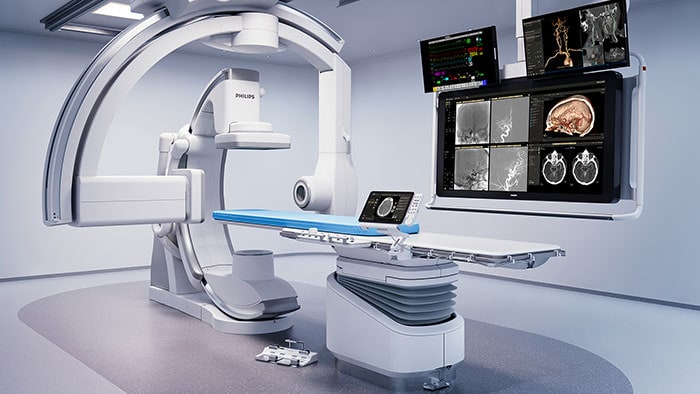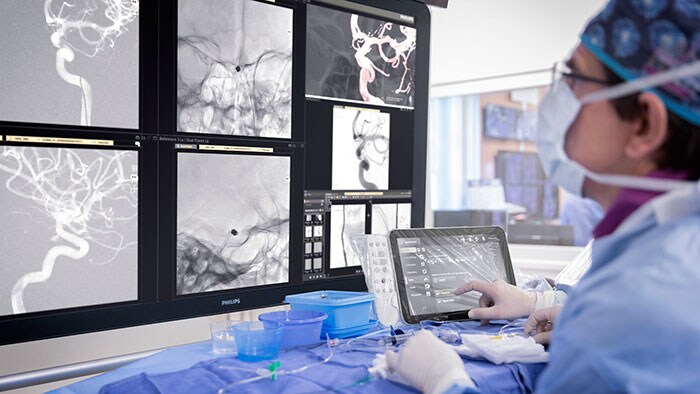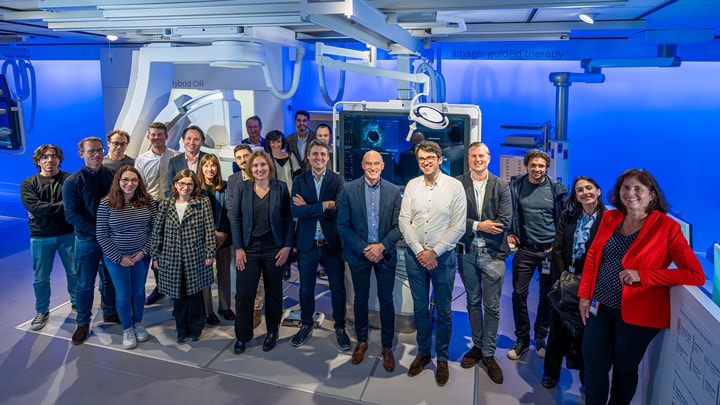Een oplossing die het laboratorium verlaat en in de operatiekamer wordt toegepast; misschien is dat wel een van de meest bijzondere momenten van iedere nieuwe innovatie. Tom Haagen beschouwt zich als een van de lucky ones die dat proces begeleidt. Elke week staat hij een aantal keer in een operatiekamer om artsen te helpen bij de behandeling van patiënten met een hartritmestoornis.
Ze maken hiervoor gebruik van KODEX-EPD, een systeem om tijdens een minimaal invasieve hartoperatie gedetailleerde 3D-beelden te maken van de hartstructuur, zonder dat gebruik hoeft te worden gemaakt van röntgenstraling of contrastvloeistof.
Om wat voor operaties gaat het precies?
"De operaties die ik begeleid zijn katheterablaties; dus behandelingen voor hartritmestoornissen die worden uitgevoerd via een slangetje. Dit soort procedures wordt vooral toegepast voor boezemfibrilleren, de meest voorkomende hartritmestoornis.
Patiënten hebben een verhoogde en onregelmatige hartslag, die wordt veroorzaakt door verstoringen van elektrische prikkels in het hart. Via zo’n operatie wordt met bevriezing of verhitting bewust littekenweefsel aangebracht in het hart zodat deze verstorende impulsen hun plek niet meer kunnen verlaten."
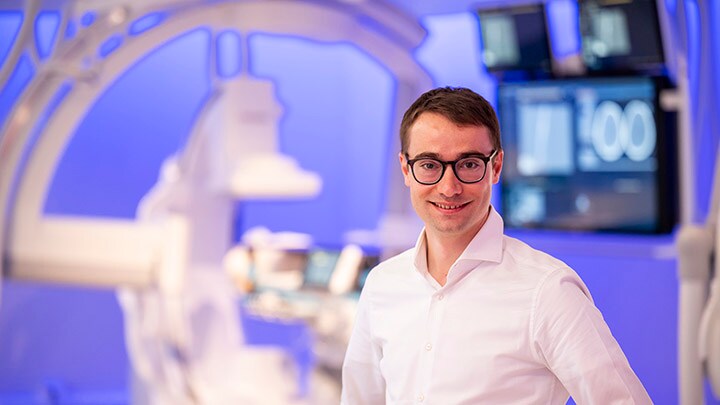
Dat klinkt als een ingewikkelde ingreep.
"De arts, een elektrofysioloog, moet vooral heel nauwkeurig kunnen werken; ze moeten het littekenweefsel precies op de juiste plek aanbrengen. Nu nog moet 20 tot 40 procent van deze procedures opnieuw omdat de operatie geen of te weinig effect heeft gehad ."
Wat is de rol van KODEX-EPD hierin?
"Katheterablaties vinden minimaal invasief plaats; via een klein gaatje in de lies wordt een speciale kathether door de bloedvaten naar het hart geleid. Met behulp van sensoren op de patiënt en de elektrodes op de katheter creëren we een elektrisch veld dat wordt geanalyseerd met speciale software. Hiermee kunnen hoge kwaliteit 3D-beelden van het hart worden gemaakt, zonder dat gebruikt hoeft worden gemaakt van straling of contrastvloeistof."
"Met dielectric sensing-technologie kunnen verschillende weefseleigenschappen in beeld worden gebracht; je gaat in de toekomst als elektrofysioloog dus hartweefseldikte kunnen zien en onderscheid kunnen maken tussen gezond weefsel en littekenweefsel. En bij katheterablatie komt dat natuurlijk enorm goed van pas, omdat je zo goed kunt zien waar je littekenweefsel moet aanbrengen."
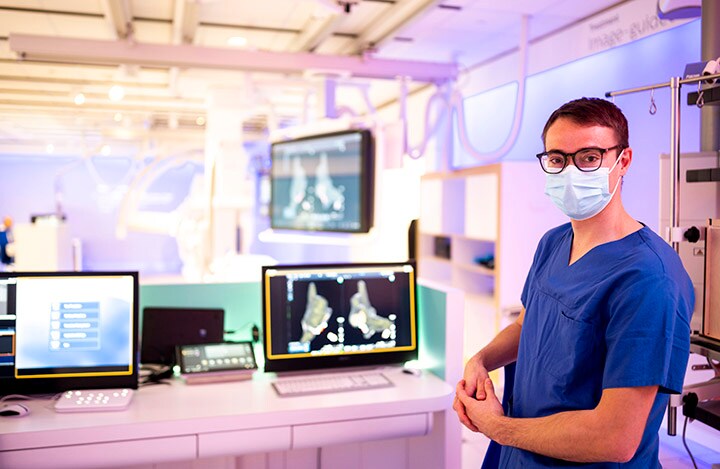
"Binnen elektrofysiologie bestaat er een soort van Heilige Graal: geen enkel systeem kon tot nu toe aantonen dat een therapie effectief en duurzaam is terwijl de patiënt nog op de operatietafel ligt. Oftewel; er was nog geen technologie om tijdens een ingreep er zeker van te zijn dat je als elektrofysioloog op de juiste plek voldoende littekenweefsel aanbrengt voor een blijvend resultaat."
Ik geloof echt dat onze technologie dat mogelijk gaat maken. Met KODEX-EPD hebben we de ambitie om geen patiënten meer naar huis te sturen die in de toekomst moeten terugkomen voor een nieuwe ingreep."
Hoe help jij een arts tijdens zo'n operatie?
"Vanuit een controlekamer help ik om het systeem goed te bedienen, maar uiteindelijk vooral ook om de arts naar de juiste plek in het hart te sturen. Zie het als een soort luchtverkeersleiding maar dan bij een hartoperatie.
Wat dit werk ook zo fascinerend maakt, is dat je aan het front staat van de uitrol van zo'n nieuwe technologie. Wij zijn met een klein team en we helpen de artsen om zo goed mogelijk gebruik te maken/ zoveel mogelijk profijt te hebben van het systeem.
Wat dit werk ook zo fascinerend maakt, is dat je aan het front staat van de uitrol van zo'n nieuwe technologie. Wij zijn met een klein team en we helpen de artsen om zo goed mogelijk gebruik te maken/ zoveel mogelijk profijt te hebben van het systeem.
Tom Haagen
Field Clinical Specialist
Daarnaast zijn wij ook het luisterend oor, verzamelen feedback van de artsen om zo het systeem steeds weer een stukje beter te maken. We werken nauw samen met R&D, maar spelen ook een rol in softwareontwikkeling."
Verwacht je dat er in de toekomst nog andere toepassingen mogelijk gaan zijn?
"Er zijn zeker meerdere ingrepen waar KODEX-EPD een alternatief kan bieden voor röntgenstraling, bijvoorbeeld het plaatsen van pacemakerdraden. We zijn echt pas net begonnen."
Hoe ben je bij Philips terechtgekomen?
“Ik heb bouwkunde gestudeerd aan de TU/e, heel wat anders. Het bedrijf waar ik hiervoor werkte, maakt katheters en ging een samenwerking aan met Philips op het gebied van KODEX-EPD. Van die technologie werd ik ontzettend enthousiast, omdat deze nog heel veel potentie heeft om een gamechanger te worden in de medische wereld, zoals minimaal invasief opereren dat zelf ook is geweest.”
Deze technologie heeft nog heel veel potentie om een gamechanger te worden in de medische wereld, zoals minimaal invasief opereren dat zelf ook is geweest.
Tom Haagen
Field Clinical Specialist
[1] *Darby AE. Recurrent Atrial Fibrillation After Catheter Ablation: Considerations For Repeat Ablation And Strategies To Optimize Success. J Atr Fibrillation. 2016;9(1):1427.
Meer weten over minimaal invasief opereren? Bekijk aflevering 1 van Made in 040!
Elke dag proberen we manieren te vinden om het leven te verbeteren, soms in kleine stapjes, soms met grote sprongen. Binnen Philips werken veel talenten aan technologische innovaties op het gebied van zorg en gezondheid. In de serie Young Innovators komen deze vernieuwers aan het woord en vertellen ze waar ze aan werken, wat hen motiveert en wat hun ambities zijn voor de toekomst.
Lees ook deze eerdere artikelen:
“Ik wil gewoon heel graag bijdragen aan innovatieve oplossingen voor de zorg”; Eline van Haaften promoveerde cum laude op haar 27e cum en kreeg verschillende onderscheidingen.
“De jongen die wolf riep”; Rohan Joshi promoveerde op alarmmoeheid op de IC. Bij Philips werkt hij aan innovaties om te vroeg geboren baby's te monitoren.
“Als wetenschapper houd ik van techniek, maar techniek zonder toepassing is niks”; in zijn promotieonderzoek maakte Rogier Wildeboer gebruik van machine learning om verschillende echotechnieken te combineren om prostaatkanker op te sporen.
Een fascinatie voor algoritmes, puzzels oplossen en het menselijk lichaam; Rozemarijn Weijers leidt een team van specialisten dat onderzoek naar de toepassing van een nieuwe mobiele röntgentechnologie in de praktijk.
“We staan met Artificial Intelligence in de gezondheidszorg aan het begin van wat er mogelijk is”; als Senior Scientist AI ontwikkelt Nicola Pezzotti nieuwe toepassingen van artificial intelligence die de gezondheidszorg verbeteren én te begrijpen zijn voor mensen.
“Ik geloof dat we de kwaliteit van leven echt kunnen gaan verbeteren door meer monitoring en betere preventie”; designer Renee Noortman ziet het als haar missie om innovatie zo goed mogelijk te laten aansluiten bij de behoeftes van patiënten.
Lena Jaschke deed als echte 'tech woman' een stap opzij, van softwareontwikkeling naar HR: "Met programmeren kun je levens redden"
"Dankzij onze robotarm maken we slimme scheerapparaten." Senior System Architect Collin Tittle is één van de getalenteerde ingenieurs die scheer- en verzorgingsproducten voor mannen ontwikkelen.
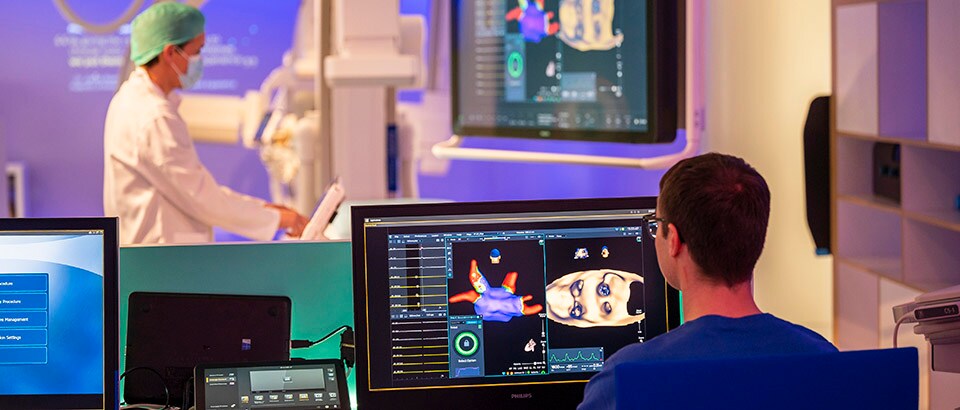
Working as an air traffic controller of heart surgeries
When you have a solution that leaves the laboratory and is applied in the operating room, this is perhaps one of the most special moments of any new innovation. Tom Haagen considers himself one of the lucky ones supervising this process. Several times a week, he is in an operating room helping physicians treat patients with heart rhythm disorders.
They are using KODEX-EPD, a system for generating detailed 3D images of the heart structure during minimally invasive heart surgery, without the need to use X-rays or contrast media.
What kind of operations are involved exactly?
“The operations that I supervise are catheter ablation procedures, which are intended to treat heart rhythm disorders and are performed through a tube. Procedures like this are mainly used to treat atrial fibrillation, the most common heart rhythm disorder.
Patients have an elevated, irregular heartbeat caused by disturbances from electrical stimuli in the heart. This procedure involves deliberately creating scar tissue in the heart through freezing or heating so that these disruptive impulses can no longer leave their site."

This sounds like a complicated procedure.
“The most important thing is that the physician, who is an electrophysiologist, must be able to work with optimum precision. They have to apply the scar tissue in exactly the right place. At the moment, 20 to 40 percent of these procedures still have to be repeated because the operation had little or no effect1."
What role does KODEX-EPD play in this?
"Catheter ablation is a minimally invasive procedure. A special catheter is guided through the blood vessels to the heart via a small hole in the groin. With the help of sensors attached to the patient and the electrodes on the catheter, we create an electric field that is analyzed with special software. This allows high-quality 3D images of the heart to be generated, without the need to use any radiation or contrast medium.
Different tissue properties can be visualized by means of dielectric sensing technology. In the future, electrophysiologists will be able to see heart tissue thickness and distinguish between healthy tissue and scar tissue. And in the case of catheter ablation, this is, of course, very useful because it allows you to clearly see where to apply scar tissue.

There is a kind of Holy Grail in the field of electrophysiology: until now, no system has been able to demonstrate that a therapy is effective and sustainable while the patient is still on the operating table. In other words, there was no technology available to ensure that during a procedure you, as an electrophysiologist, applied enough scar tissue in the right place to achieve a lasting result.
I really believe that our technology is going to make this possible. With KODEX-EPD, it is our ambition to stop sending patients home who will have to return for a new procedure in the future."
How do you assist the physician during this kind of procedure?
“From a control room I help to operate the system properly, but ultimately also to guide the physician to the right place in the heart. Think of it as being a bit like an air traffic controller, but for heart surgery.
What also makes this work so fascinating is being at the forefront of the rollout of such new technology. We are a small team and we help physicians make the most effective use and gain maximum benefit from the system.
What makes this work so fascinating is being at the forefront of the rollout of such new technology. We are a small team and we help physicians make the most effective use and gain maximum benefit from the system.
Tom Haagen
Field Clinical Specialist
In addition, we also listen attentively to and collect feedback from physicians so that we can continue to make improvements to the system. We collaborate closely with R&D, but also play a role in software development."
Do you expect other applications to be possible in the future?
“There are certainly multiple procedures where KODEX-EPD can offer an alternative to using X-rays, such as for placing pacemaker wires. We really only just got started."
How did you end up working at Philips?
"I studied civil engineering at Eindhoven University of Technology, so something quite different. The company I previously worked for manufactures catheters and established a partnership with Philips for the development of KODEX-EPD. I was extremely passionate about this technology because it still has a lot of potential to become a game changer in the medical world, just as minimally invasive surgery itself has been."
This technology has a lot of potential to become a game changer in the medical world, just as minimally invasive surgery itself has been.
Tom Haagen
Field Clinical Specialist
[1] *Darby AE. Recurrent Atrial Fibrillation After Catheter Ablation: Considerations For Repeat Ablation And Strategies To Optimize Success. J Atr Fibrillation. 2016;9(1):1427.
Every day we are looking for ways to improve life - sometimes in small steps, sometimes in big leaps. Within Philips, many talents are working on technological innovations for care and health. In the Young Innovators series, these innovators have their say; what are they working on? What drives them? What are their ambitions for the future?
Also check out these previous episodes:
“The boy who cried wolf”; Rohan Joshi was promoted on alarm fatigue in the IC. At Philips, he is working on innovations to monitor premature babies.
“As a scientist I like technique, but technique without application is nothing”; in his doctoral research Rogier Wildeboer used machine learning to combine different ultrasound techniques to detect prostate cancer.
A fascination for algorithms, solving puzzles and the human body; Rozemarijn Weijers leads a team of specialists investigating the application of a new mobile X-ray technology in practice.
With Artificial Intelligence in healthcare, we are at the beginning of what is possible; as a Senior Scientist, Nicola Pezzotti develops AI methods that improve healthcare, are applicable in practice, and easy to understand for humans.
"I believe we can really improve the quality of life through more monitoring and better prevention"; designer Renee Noortman sees it as her mission to make innovation meet the needs of patients as well as possible.
Lena Jaschke decided to take a step aside; as a 'true tech woman' she decided to move from software development to HR. "Coding can save lives"
"Thanks to our robot arm we develop smart shavers." As a Senior System Architect, Collin Tittle is one of the talented engineers that work on the development of male shaving and grooming products.
